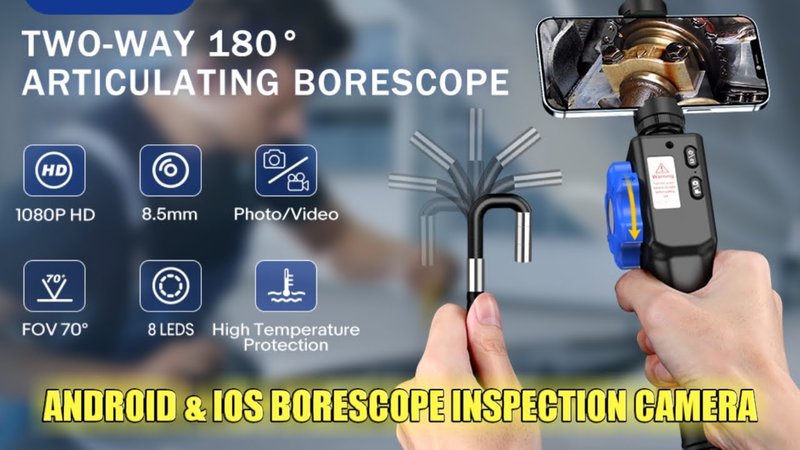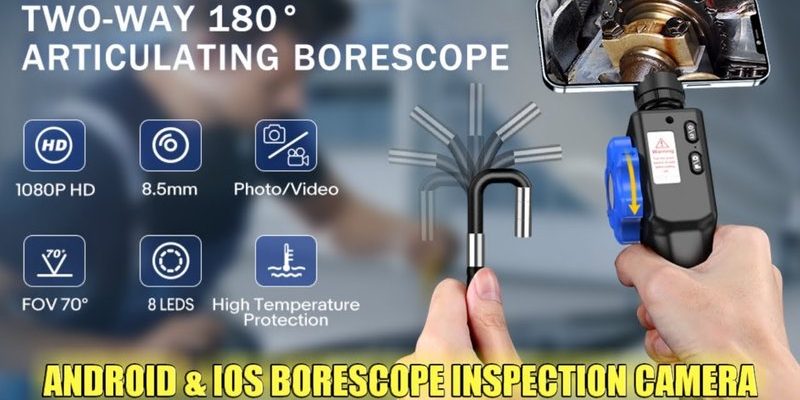
In simple terms, a bore scope (sometimes called an endoscope or inspection camera) is a small camera on a long, bendy cable. You connect it to your phone, tablet, or a handheld screen—brands like Depstech, Teslong, and others make these gadgets super accessible. Whether you’re troubleshooting a car engine, checking for leaks behind drywall, or hunting down that lost bolt in your lawnmower, learning how to use a bore scope can save you time, money, and a lot of frustration.
Let’s look at how bore scopes work, the steps to use one, and some real-world tips for making the most out of this surprisingly handy tool.
What Is a Bore Scope and How Does It Work?
Here’s the thing: A bore scope is basically your eyes on a cable. Most models have a small camera and LED lights at the end, all attached to a flexible tube. You plug the other end into your phone, a dedicated display, or even your laptop. When you snake the camera into small or hard-to-reach spots, you get a live video feed of what’s going on inside.
You might be wondering, “Do I need fancy tech skills to use one?” Nope. Many modern options, like the Depstech WiFi bore scope, are almost plug-and-play. You install a simple app, connect the bore scope, and you’re ready to peek inside whatever you want—walls, engines, pipes, or even behind appliances.
Bore scopes come in different shapes and sizes. Some are rigid (better for straight lines, like gun barrels), while most consumer models are flexible. The cable’s length varies, but even the basic ones usually reach at least three feet. The big advantage is being able to *see* without breaking things open. That means less guesswork and more precise troubleshooting.
Common Uses for a Bore Scope in Hardware Inspection
Honestly, once you try a bore scope, your mind starts racing with uses. The obvious ones: checking engine internals, peering into dryer vents, or inspecting for water damage inside walls. But there are also tons of situations where a bore scope saves the day.
- Automotive repair: If your check engine light is on, a bore scope helps you spot stuck valves, clogged injectors, or corroded wiring without taking the whole engine apart.
- Home maintenance: Got a mysterious leak or an odd smell? A bore scope lets you look behind sinks, inside ductwork, or down drainpipes to find the culprit.
- Electronics: Sometimes a small screw falls deep inside a computer or a game console. Bore scopes help you locate and retrieve tiny parts without damaging delicate hardware.
- Appliance troubleshooting: Ever tried to figure out why your washing machine rattles? A camera on a cable can spot stuck objects or broken parts you’d never see otherwise.
Let me tell you—using a bore scope quickly becomes second nature. Once you see what’s hiding in your walls or under your car’s hood, you get hooked on solving problems the *easy* way.
Getting Started: What You Need Before Using a Bore Scope
Before you dive into your first inspection, you’ll want to make sure you’ve got the right gear and a few minutes to set things up. Here’s what you’ll need:
- A compatible bore scope: Double-check if the model, like a Depstech or Teslong, works with your phone or computer. Some use USB, others rely on WiFi or their own display.
- Charged batteries or power: If your bore scope is wireless, make sure its battery is topped up. For wired models, ensure your device is ready.
- The right app or software: Most bore scopes need a free app you’ll find in the App Store, Google Play, or the brand’s website. Download and install it before you start.
- Good lighting and workspace: Even though bore scopes have LEDs, it helps to work in a tidy area so you don’t knock things over while snaking cables.
Trust me, running out of battery or realizing your bore scope doesn’t fit the inspection point *after* you start is annoying. Take a minute to prepare—your future self will thank you.
How To Use a Bore Scope: Step-by-Step Guide
Let me explain the basic process. You might feel a little clumsy your first time, but don’t stress—most people get the hang of it fast. Here’s how to use a bore scope for inspecting hidden hardware issues:
- Connect or sync your bore scope: Plug it into your device or connect over WiFi. Open the bore scope’s app or software and check that the video feed works.
- Power up the LED lights: Good visibility is key. Adjust the LED brightness so you don’t get glare or dark corners in your image.
- Insert the camera gently: Slide the camera end slowly into the inspection spot. For tight angles, use the cable’s flexibility, but don’t force it or you might damage the lens or your hardware.
- Watch the live video feed: Move the camera bit by bit, watching the screen for anything unusual—loose screws, corrosion, dirt, or damage. Take photos or videos if you spot something to show a repair person later.
- Retrieve and clean: When you’re done, pull out the bore scope carefully. Wipe the camera tip so it’s ready for the next job.
Here’s a tip: Try the controls before you start. Some bore scopes let you rotate the image, zoom, or tweak settings in-app. Playing with these features makes inspections much smoother.
Troubleshooting Common Bore Scope Problems
You might be wondering—what if something goes wrong? Like any tech, bore scopes have their quirks. Some problems pop up more often than others, and most are easy to solve.
Can’t connect or no video feed? Double-check the cable connection, WiFi pairing, or app permissions. Sometimes, “resetting” the bore scope or rebooting your phone solves odd glitches. If you’re using a battery-powered model, the battery could be low or dead.
Blurry or dark images? Make sure the lens is clean—dust and smudges can wreck image quality. Adjust the LED brightness, or tap the focus controls if your bore scope supports it.
The camera won’t fit? Some spaces are too small, even for a bore scope. Try a thinner model, or consider using a mirror on a stick as a very basic alternative (not nearly as good, but better than nothing).
If you’re stuck, don’t be afraid to check the manual. Most brands, like Depstech, have online guides and troubleshooting help. A quick YouTube search can also show you step-by-step fixes.
Why a Bore Scope Beats Traditional Inspection Methods
Let’s be real: Before bore scopes, most people had two options—tear things apart or make wild guesses about what might be broken. That means wasted time, expensive mistakes, or missing the real problem completely.
A bore scope lets you:
- Spot hidden hardware issues instantly without disassembling the whole device.
- Document what you find—photos and videos make repairs (and warranty claims) much simpler.
- Reduce downtime by diagnosing issues faster, whether it’s in a car, appliance, or wall cavity.
Compared to poking around with a flashlight and a mirror, using a bore scope almost feels like cheating. You find and fix problems that would otherwise stay hidden, saving yourself serious headaches and money in the long run.
What To Look For When Buying a Bore Scope
Not all bore scopes are created equal. If you’re in the market for one, a few features matter way more than others. Here’s what I’d check—and what you might want to consider before you buy:
Cable length: Will you be checking deep inside car doors or just peering behind your fridge? Get a cable long enough for your usual jobs, but not so long it’s unwieldy.
Camera quality: Look for at least 720p resolution, though 1080p is way better for spotting small defects. Some models let you swap out different lenses for wide vs. close shots.
Device compatibility: Make sure it works with your phone, tablet, or whatever device you already have. Some models are iPhone-only, others need Android, or work with both.
LED brightness and controls: Adjustable LEDs are a must. You want to be able to see in dim, dusty corners just as well as open spaces.
Brand reliability: Companies like Depstech, Teslong, and BlueFire tend to have the best software support and longevity.
If you want to compare alternatives, some traditional inspection mirrors or snake cameras do a similar job, but they lack the clarity, recording function, and easy sharing you get with a true bore scope.
Pro Tips for Better Bore Scope Inspections
Once you’ve got the basics down, a few tricks make your inspections even smoother:
- Practice first—try the bore scope out on something simple (like a drain or under a couch) to get used to the controls before tackling delicate hardware.
- Keep the lens clean—a tiny bit of gunk on the camera will ruin your images. Wipe gently with a soft cloth before and after each use.
- Label your photos—if you’re inspecting lots of spots, especially in cars or walls, use the app’s folder or tag feature so you can tell them apart later.
- Don’t force the camera—if it gets stuck, back out slowly. Forcing it can break the device or scratch up your hardware.
With a little patience, you’ll be solving mysteries that used to stump professionals. The confidence boost is real.
Closing Thoughts
Learning how to use a bore scope for inspecting hidden hardware issues is a game-changer. You get a window into places you’d normally never see, letting you diagnose, document, and fix problems with confidence. Whether you’re a homeowner, a car enthusiast, or just someone who hates not knowing what’s wrong with your gear, a bore scope is one of those tools you’ll wonder how you lived without. Take your time, get comfortable with the controls, and pretty soon, you’ll be spotting issues in minutes—without ever reaching for the sledgehammer.
